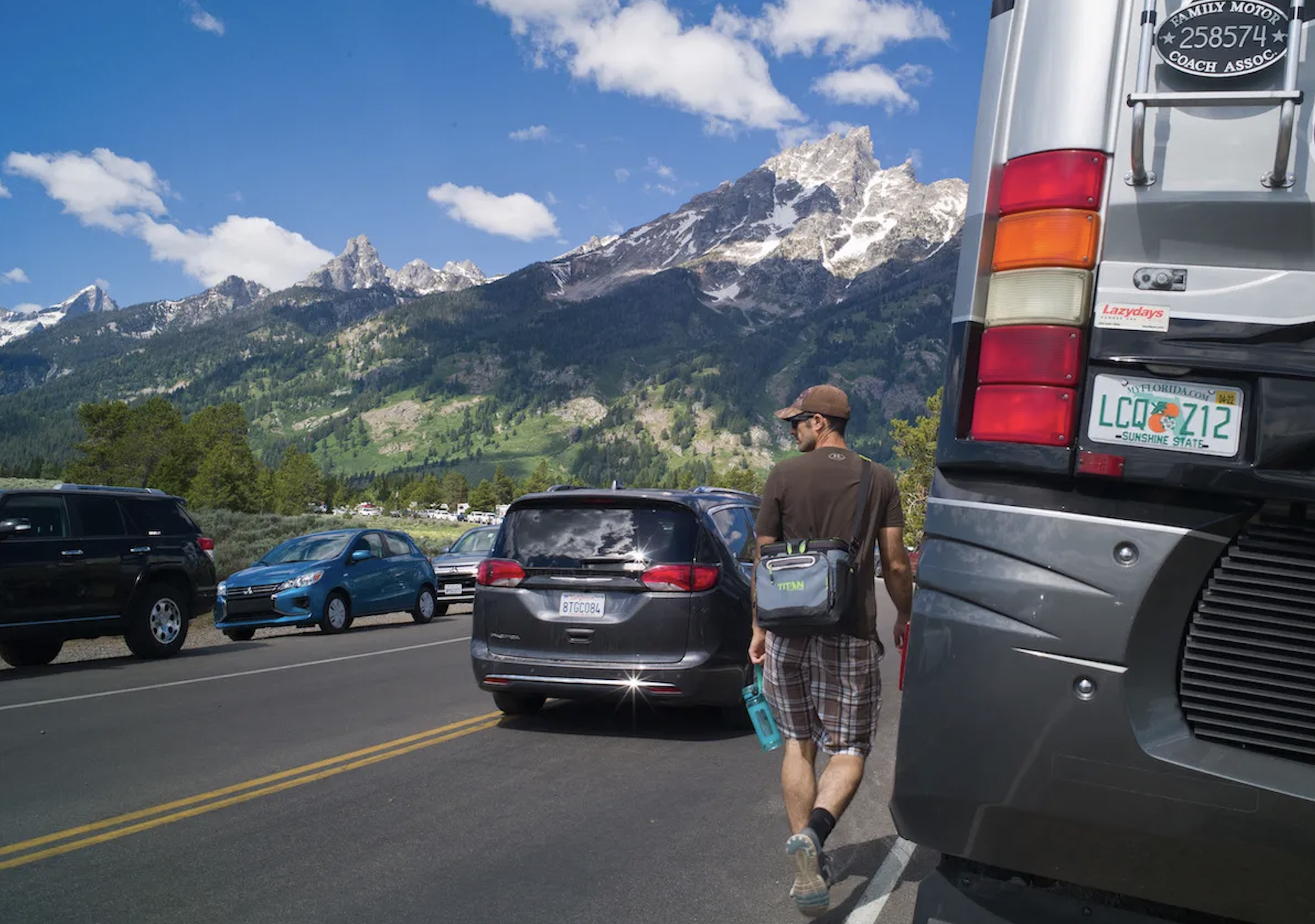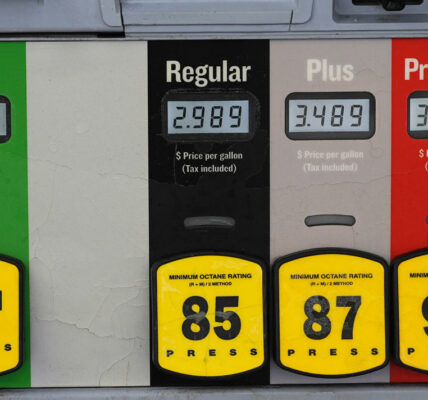
By Katie Klingsporn, WyoFile.com
Though growing visitation to Yellowstone and Grand Teton National Parks has led to overflowing parking lots and traffic snarls, superintendents say visitor patterns and geography make transitioning to shuttle systems unlikely anytime soon.
Citing separate studies, Yellowstone Superintendent Cam Sholly and GTNP Superintendent Chip Jenkins recently said parkwide shuttle systems don’t make sense for the popular northwestern Wyoming destinations. That’s because visitors often drive in one entrance and out another and the costs of shuttling them would be huge, among other reasons.
“I don’t foresee anytime in the future a parkwide shuttle system,” Sholly said. A shuttle system, he said, is “not going to solve everything” related to congestion.
Their stances cast doubt on one of the tools people have looked to mitigate the effects of crowds in the parks’ most popular spots.
Rising visitation has stressed parts of both parks as maintenance budgets, aging infrastructure and staff numbers lag behind the growth. Visitation was relatively steady for much of the 1990s-2000s, but that began to change in the mid-2010s, fueled by factors such as the 2016 “Find Your Park” campaign, the growth in outdoor recreation participation and the 2017 solar eclipse. The pandemic only accelerated the trend.
In GTNP, for example, 2021 brought a record-breaking 3.9 million visits — a 50% increase from a decade earlier.
In response, the park has been experimenting by limiting vehicles at crowded lots and requiring camping reservations. The park in 2021 studied traffic patterns, trail-use numbers and visitor experiences. Grand Teton shared an executive summary of the report in late February.
In a press call about that study, Superintendent Jenkins stressed that 91% of vehicles that enter the park stop at least once somewhere in the park, and most make multiple stops.
“The way that people come and visit Grand Teton is not really what many people expect,” Jenkins said. “It’s very complicated. There’s not necessarily a normal pattern. And what we really learned is that visitation is highly dispersed, highly varied and that there is no dominant travel pattern.”
That reality, Jenkins said, “sets up a really interesting … both question and dilemma for us.”
If the park were to shift away from private transportation, he said, it would strip people of the autonomy to visit the way they appear to enjoy. “Driving in their private vehicle affords them that opportunity to continue this kind of visitor experience,” he said.
Only about 5% of visitors are local residents, Jenkins said, who use the park differently from out-of-towners; locals tend to drive directly to their destination, while visitors meander and stop at turnouts to take in the scenery. In addition, the study shows visitors enter from various areas — from Dubois, Jackson and Yellowstone, for example.
There have been calls to expand the regional transit system into the park, Jenkins said, and the park is open to exploring the feasibility with stakeholders.
But the idea of an alternative transportation system, he said, would entail either having to “fundamentally change the kind of experience people had, or you would have to have such a web of connections that it’s a pretty complex system.”
Not only would a shuttle system be insufficient to fix the park’s traffic problems, he continued, “conversely, it might create a whole bunch of other problems.
“And while there are many people who have ideas and thoughts about what solutions might be to problems,” he said, “part of what we’re trying to figure out is … exactly what the problems are.”
The data will help the park understand what is happening in the park as visitation mounts, Jenkins said. The park already identified several places — such as Jenny Lake, Lupine Meadows and Taggart Lake — where parking demand exceeds spaces, and will “continue to experiment” with alternatives.
A shuttle may still come to the park, though from another source. The Southern Teton Area Rapid Transit operates a robust transit system in the Jackson area that includes in-town and commuter rides.
“The START board, and, you know, many citizens, including the county commission, have long talked about service up to the park, and that now is one of our top priorities,” board Chair Jared Smith said. “But we also acknowledge that it’s very challenging to come up with viable solutions” given the park’s use patterns.
START hopes to identify funding to do pilot or demonstration projects in the near future that would provide service to the park, he said.
Yellowstone National Park entered 2022 intending to celebrate its 150-year anniversary, but historic floods in June threw a wrench into those plans, wiping out roads and forcing closures. Visits dropped 32% from the record 4.9-million tally of 2021.
Still, Sholly expects numbers to rebound fairly quickly back to the “normal range” of about 4 million and continue to grow. Though the flood diverted park officials’ attention last year, the park has not stopped thinking about how to solve challenges around managing growth, he said.
To that end, a transit feasibility study was completed in late 2022. Though alternative transportation is “consistently pointed to by park visitors and employees, the public and key stakeholder groups,” it reads, those options have been minimally explored in previous reviews. The study aimed to do that — with a focus on whether transit services for the busy Old Faithful-Madison corridor and Canyon Village areas are feasible, and “whether transit would significantly reduce traffic congestion, improve visitor mobility, and address key park concerns.”
The study found that several concepts — such as closing certain zones to all but pedestrian/bike/transit traffic — would result in less congestion and/or more parking. But they would also bring major infrastructure, staffing and overhead costs, and none of the concepts met park “achievability criteria.”
“At least in this park, it’s unclear exactly how positively impacting that would be on traffic and congestion and things like that,” Sholly said of a shuttle system, especially compared to the cost of the investment, which he called “monumental.”
The park’s size, with five entrances and roughly 500 miles of road, would further complicate the logistics of shuttle travel planning, he said.
While it was a valuable exercise, Sholly said, the study also underscored that shuttles alone won’t solve all the congestion problems — especially without a guarantee that people will use them.
The study added that “congestion could be also controlled by just managed access, regardless of whether there was transit service.”
Sometimes, Sholly said, measures aimed at alleviating the problems only compound them. When the park added a temporary parking lot near Midway Geyser Basin in 2017, for example, it didn’t add trash cans and bathrooms. “So what we’ve seen in our monitoring … is a lot more litter, human waste, social trails, things like that.”
The park is planning to replace that temporary lot with a permanent one that could only be used through a “timed-entry system,” he said. That process will be open to the public, he said.
Visitation to both parks slowed in 2022, a trend likely influenced by flooding. Even without the disaster, however, a nearly universal slowing of visitation across Wyoming public lands indicates it likely would have been a softer year.
Jenkins and Sholly believe visitation growth will generally continue, though not as dramatically as 2021. In some respects, Jenkins said, that anomaly was a gift, because “we have a glimpse of the future.”
Much of this conversation, Sholly said, centers around the question of what number triggers action to prevent resource impacts or reduce congestion. “And that’s not an exact science.”
As visitation increases, he said, “I have no doubt some of those actions will have to get more aggressive. But I don’t think right this second we’re at a point where we need to cap visitation, and also I can’t tell you exactly where that threshold is.”
It’s going to take thoughtful conversations that include stakeholders, including gateway communities like Cody and Jackson, Sholly said. “We’ve got significant issues, in certain parts of the park at certain times of the year, that need to be addressed. But they need to be addressed strategically.
WyoFile is an independent nonprofit news organization focused on Wyoming people, places and policy.





